Over the last 6-8 months we’ve seen watch companies, including Garmin and COROS, add multi-band/dual-frequency GPS chipsets to their watches, which have long-promised to be the holy-grail of GPS accuracy. As I’ve shown in my in-depth reviews though, that promise is sometimes a bit far-fetched. Yes, things are better than before – but not always substantially, or even noticeably, better.
But one trend I’ve noticed is that both Garmin and COROS have been improving their GPS tracks. The changes from last August with the COROS Vertix 2 and multi-band GPS to December were noticeable. Not major, but slightly better. And even the GPS tracks I got in January versus March on the Fenix 7 or Epix Sapphire editions (which contain multi-band GPS) were again, noticeable.
So I recently had a flight layover in New York City, giving myself and my wife just enough time to put these top two models to the test. Of course, like any test, things got out of hand quickly. And before I knew it the two of us were armed with 7 GPS watches testing out all sorts of theories. And let me tell ya: There were some surprises here.
You can certainly read the entire accuracy test below, though realistically you’ll probably find the video more detailed in some areas since the post only contains screenshots of certain GPS tracks, whereas the video shows the full length of the tracks.
The Test Setup:

For this test, my main goal was to do a head-to-head between the Garmin Fenix 7 Solar Sapphire and the COROS Vertix 2 – both of which have multi-band GPS. I wanted to see how well these would handle in what is generally seen as the most difficult GPS conditions in the world (Manhattan). I’ve traveled to 80+ locations in the world, and countless mountains and other locales – and nothing holds a candle to the GPS-hell that is Manhattan, especially around the Times Square area.
However, as always, I start getting curious about other things. How much better is Fenix7 Sapphire versus non-Sapphire? That’s because the Sapphire edition is the one that has the multi-band/dual-frequency GPS, whereas non-Sapphire doesn’t (both use MediaTek (aka Airoha)). And then from there I started pondering – OK, how much better is the Airoha chipset in the Fenix 7 base edition compared to the older Sony chipset in an Instinct 2 or Descent G1? And certainly, someone will ask about the Epix too. As you can see, stuff got out of control quickly. I also had planned to take an Apple Watch Series 7 with me, but it was failing to charge that afternoon, and after waiting an hour, I eventually gave up on it. Next time!
The contenders:
COROS Vertix 2: Multi-band/dual-frequency
Garmin Fenix 7 Solar Sapphire: Multi-band/dual-frequency
Garmin Fenix 7S Solar Sapphire: Multi-band/dual-frequency
Garmin Fenix 7 Base: All Satellites (Basically GPS+GLONASS+GALILEO)
Garmin Epix Gen2 Sapphire: Multi-band/dual-frequency
Garmin Instinct 2 Base: GPS+GLONASS
Garmin Descent G1 Solar: GPS+GLONASS
Now for today’s test, my wife and I ran side by side on the same route at the same time. So practically speaking, these GPS tracks should be identical. While technically speaking, you can see differences between different individuals due to body blockage, I don’t consider that a valid excuse for poor GPS. If a person’s height or being a couple of feet to the left/right/ahead/behind is the singular consideration for good GPS, then the issue is the watch – not the person. Certainly, in a race you wouldn’t know where the ‘perfect’ spot is for GPS at all times.
Similarly, I don’t consider choosing left vs right wrist a valid excuse for poor GPS in most situations. The only scenario where I’d give that a pass was if you ran on a sidewalk *right up against* these tall buildings the entire time with just one side against the buildings. But we ran in the street and also flipped sides halfway through.
Here was my running setup:
Left wrist: Garmin Fenix 7 Solar Sapphire
Left hand: Garmin Fenix 7 Base
Right wrist: COROS Vertix 2
Right hand: Garmin Descent G1 Solar
My rough goal here was basically to have the two main multi-band contenders on opposite wrists, with the two non-multi-band options complimenting it on opposite wrists. Which ultimately looks like this (obviously HR is discarded from the hand-watch):
This setup is actually how most wearable companies will test units from a GPS standpoint. This means the watches have near-identical visibility to the sky, without blocking each other. Further, it reduces issues with ‘bouncing together’, when you put two watches on the same wrist next to each other. Obviously, for the watches out on the hands, there’s no optical HR (from a test validity standpoint, in reality, it works surprisingly well). But I didn’t care about optical HR today.
Meanwhile, my wife had:
Left wrist: Garmin Fenix 7S Solar Sapphire
Left hand: Garmin Epix Sapphire
Right wrist: Garmin Instinct 2 Base
Now, finally, note that in order to make this test representative of normality, all of the units were paired to their respective apps and had their GPS satellite pre-cache synced ahead of time (EPO file). This automatically happens on your watch, which speeds up finding satellites massively (from minutes to seconds). Further, after landing at the airport (Newark), I had all GPS units find a signal there briefly – before heading into the city. Thus, they at least knew which region they were in (coming from Amsterdam).
Got all that? Good. Let’s get going.
Running the route:
This is a route that I have used for over a decade to test GPS watches. I use the same route so I can most easily look back on these tests over the next decade, and compare them to stuff from the Forerunner 305 era. The test starts out a few blocks from Times Square, standing between 60-story buildings. I then run half a dozen or so blocks to Central Park, where I do a loop around that, following the road. I do this because while GPS can often suck in the building portion, I want to see if it can properly lock-in on the right tracks as it gets to more open areas in the park (historically, the answer has varied quite a bit).
Further, while Central Park is mostly open (with light tree cover), it’s surrounded by tall buildings, which often cause GPS signal reflection errors. So it’s harder than it might appear.
With that, we headed outside and started all the units to find GPS. Lock-times were pretty darn quick across the board. They were as follows:
COROS Vertix 2 Multi-band/dual-frequency: 10 seconds
Garmin Epix Gen2 Sapphire Multi-band/dual-frequency: 20 seconds
Garmin Fenix 7 Solar Sapphire Multi-band/dual-frequency: 20 seconds
Garmin Fenix 7S Solar Sapphire Multi-band/dual-frequency: 28 seconds
Garmin Instinct 2 Base GLONASS: 28 Seconds
Garmin Fenix 7 Base All Satellites: 32 seconds
Garmin Descent G1 Solar GLONASS: 34 seconds
From there, the first section was in the buildings, and you can see that while these units proclaimed lock/ready status, in reality, they wouldn’t reach their peak GPS satellite lock till later. Here’s how the two top contenders faired – the Garmin Fenix 7 Solar Sapphire and COROS Vertix 2 (both multi-band). Note that you can watch the full track progression in the video:
As you can see, the Garmin easily beat the COROS Vertix 2 for the first 4-5 blocks, with the Vertix 2 off in the buildings. While the COROS Vertix 2 got GPS quickest, it’d be interesting to know exactly what their threshold is for number of satellites locked versus Garmin’s threshold. For fun, here’s a look at when I add in the orange of the Garmin Fenix 7 Base unit (which uses the same GPS chipset provider, but not in dual-frequency mode), it’s not much different:
In any case, here’s another two dual-frequency units from my wife (Epix Sapphire & Fenix 7S Solar Sapphire), which are still roughly on the roadway, albeit not the right side. But hey, it’s not inside a building.
However, if I throw in the other Garmin watches using the older chipset from Sony, it’s clearly inferior to the multi-band ones, though the Instinct 2 base managed to pull through here.
Next, let’s shift out to the park itself. And here it didn’t take long for these watches to quickly lock on. Overall, the results were very very similar among all of them. However, it was abundantly clear that the Garmin dual-frequency ones nailed the exact running path lane we were in (which is basically a converted bike lane on the roadway), the COROS was generally the correct side of the road, and the non-dual-frequency ones were basically like “here’s the entirety of the road, it’s close enough”.
This is notable – and actually an improvement over what I saw in the December-January timeframe of testing for Garmin/COROS, or last summer for COROS only, where they didn’t often nail the correct side of the road – even in easy situations.
Here’s the non-dual-frequency ones, which you can see aren’t quite as crispy.
Sure, there’s not much tree cover this time of year yet, but nonetheless, with occasional reflections from nearby buildings as I’ve seen in the past.
Ok, so let’s get into the real meat of things, getting back from Central Park to Times Square, which is roughly 15ish blocks of skyscraper hell. Here’s a look at the route they’d be taking:
Starting off with the dual-frequency COROS Vertix 2 and Garmin Fenix 7 Solar Sapphire, you can see that while they were close, it’s clear the Fenix 7 was better. It was almost always within one lane of where we ran, whereas the COROS did some building busting (albeit, it did catch up after a few blocks):
Here’s the dual-frequency units my wife was wearing (Epix Sapphire & Fenix 7S Solar Sapphire):

Here’s adding in the orange track of the Fenix 7 Base:
And now, compare that to the non-dual-frequency ones with the older chipset, which…was mostly a hot mess in the buildings. Albeit, I guess you could decide whether it or the COROS Vertix 2 were worst for the first few blocks. Depends on which buildings you like or dislike I suppose.
Oh, and the final distances as read off in the video (and full data sets here):
COROS Vertix 2: 11.58km
Garmin Epix Sapphire: 11.65km
Garmin Fenix 7 Solar Sapphire: 11.56km
Garmin Fenix 7S Solar Sapphire: 11.49km
Garmin Fenix 7 Base: 11.57km
Garmin Instinct 2 Base: 11.76km
Garmin Descent G1 Solar: 11.51KM
It’s at this moment that you realize just how far we’ve come in a very short timeframe. It’s impressive – these dual-frequency watches are now good enough to get reasonably accurate and useful GPS tracks on one of the hardest streets in the world, with minimal real-world impact to battery life (or any other compromises, like size or weight).
Wrap-Up:
I think it’s also interesting to see the progression being made by both Garmin and COROS with dual-frequency chipsets accuracy. When COROS first rolled out dual-frequency support last August, it was at best ‘meh’. As I showed over and over again in data sets in my review then, there were very few scenarios where it was meaningfully better or different (even in the mountains). Most of the time you wouldn’t be able to tell the difference.
Fast forward a few months later to December, in similar terrain/routes, and the Vertix 2 was showing notable improvements in accuracy compared to summer. And that was alongside Garmin’s Fenix 7 & Epix units I was testing, while those were alongside older non-dual-frequency units that served as a good baseline. In that December/January timeframe, you could start to see meaningful differences between having dual-frequency and not – especially in hard GPS locations (mountain cliffsides and buildings), but also even in more casual day-to-day situations. And at the time, it was clear that while the COROS Vertix 2 could easily beat any Garmin non-dual-frequency GPS watch accuracy-wise, it wasn’t generally better in accuracy than the Fenix 7 or Epix Sapphire editions in GPS accuracy. Despite using the same GPS chip provider, Garmin was simply more accurate both in hard situations and easier ones. But the difference to non-dual-frequency in easier scenarios was less obvious.
Now, here we are another 3 to 4 months later, and the improvements keep coming from both companies. Like before, as you can see Garmin is still leading in GPS accuracy (and this matches my day-to-day testing/usage too where I often employ the Vertix 2 as a comparison point), but COROS still easily beats most non-dual-frequency watches.
The one interesting caveat is the Fenix 7 base unit (the cheapest one), which, seems to split the difference there. In fact, I think at the right party with enough drinks it could pass itself off as dual-frequency GPS tracks. Unlike the older watches, it has the same GPS chipset provider as the Fenix 7/Epix Sapphire with dual-frequency. And for all we know, it might actually be the exact same chipset inside (with simply software enablement of dual-frequency). Nobody has decided to sacrifice $1,600 worth of watches to find out.
The next question is: How long do we have to wait till we get this type of accuracy on more affordable watches from these companies? Hopefully soon. And then secondarily – if these are the improvements to accuracy via firmware we’ve seen in 6-8 months, what will the next 6-8 months bring?
With that – thanks for reading!
FOUND THIS POST USEFUL? SUPPORT THE SITE!
Hopefully, you found this post useful. The website is really a labor of love, so please consider becoming a DC RAINMAKER Supporter. This gets you an ad-free experience, and access to our (mostly) bi-monthly behind-the-scenes video series of “Shed Talkin’”.
Support DCRainMaker - Shop on Amazon
Otherwise, perhaps consider using the below link if shopping on Amazon. As an Amazon Associate, I earn from qualifying purchases. It doesn’t cost you anything extra, but your purchases help support this website a lot. It could simply be buying toilet paper, or this pizza oven we use and love.



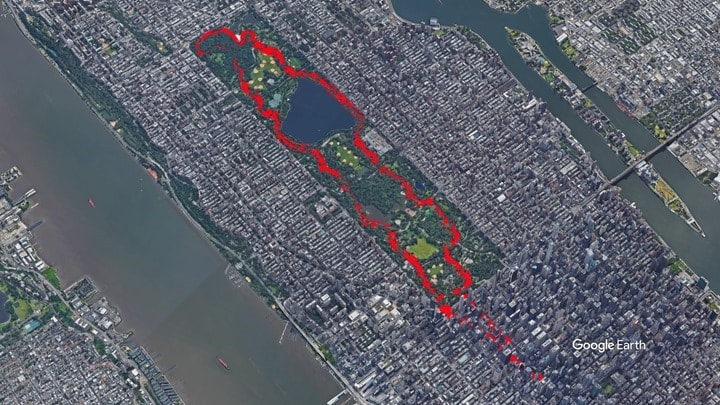

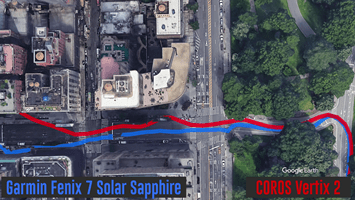



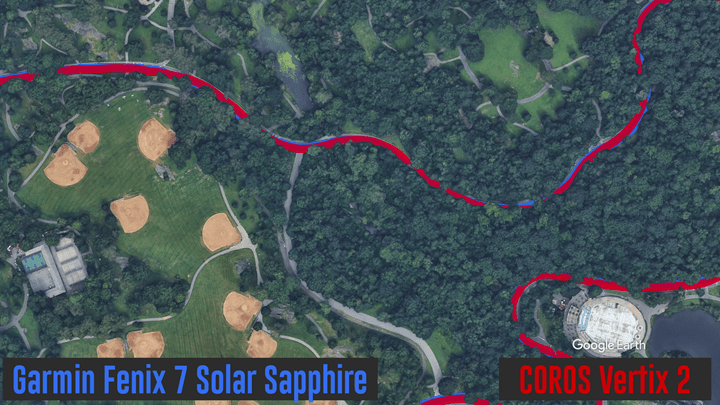


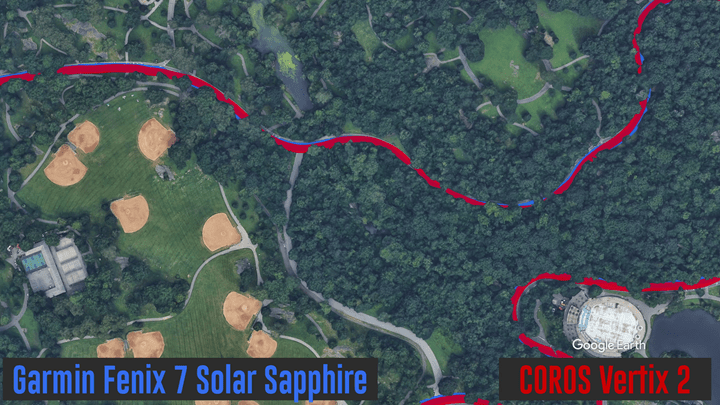
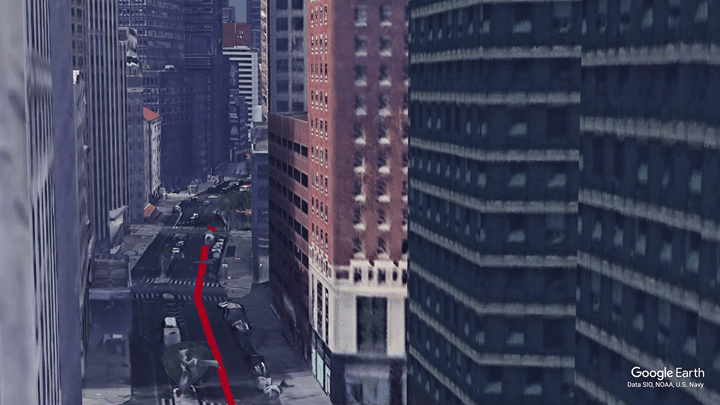



















Which software version did you use on the Fenix 7 / Epix 2? There seems to be some small improvement with the 8.1x betas in GPS accuracy.
Fenix 7’s/Epix Sapphire were on 8.09, which is basically just ahead by a day or two of the 8.1x betas you have now. However, the Fenix 7 base was on 7.35, which is the public production version.
8.09 is not a public beta, i’m curious :-)
You right 8.1x does not explicitly provide GPS/Satellite/position/etc. fix or improvement.
link to gpsinformation.net
8.09 is basically just 8.1x before toggled to the public beta. Same features.
This was super interesting. I’ve never seen such a good comparison of GPS watch tracking abilities.
Do you think any of the differences could be a result of the particular satellites that the watches connect to? Would Garmin watches have any kind of affinity with particular satellites that might have better signals? Or do you think that they all connect to the same satellites (within single/dual bank of course) and it’s just the management of those signals that is done better or worse watch to watch?
Again, on the edge of my seat the whole time rooting for the Fenix 7 base to pull out a win against the odds. Thanks!
Definitely could have different satellites in view, for sure. Unfortunately, while COROS does display a numerical identifier in the settings panel, it doesn’t require it in any publically viewable way that I’m aware of.
And Garmin doesn’t show it anywhere that I know of (again, I’m sure it’s somewhere in that .FIT file, but it’s not accessible as far as I know).
How detrimental is this to instantaneous pace?
It’s rougher in the buildings. If you look at the raw data charts on the DCR Analyzer, you can see what each unit recorded, per second, for it’s current pace: link to analyze.dcrainmaker.com
As you can see, it was all rainbows and flowers in the park, but super variable at the beginning/ending in the buildings.
Hi Ray, One small issue- the Epis/Fenix 7S photo in the buildings is actually the Fenix/Coros photo repeated.
Otherwise, very interesting. Do you have an up-tp-date estimate on the dual band battery penalty on the Fenix/Epix?
Ahh, good catch! Will grab correct screenshot here in a second!
I wasn’t super focused on battery during this test, so I wouldn’t say everything was equal there. Nor was this a long enough test (duration) to get proper battery burn specs.
Still…the Fenix 7 Base (non-multiband) was reporting 2.18%/hour, while the Fenix 7 Solar Sapphire was at 4.36/hour. My wife’s Fenix 7S Solar Sapphire at 5.54%/hour, and Epix at 6%/hour (all multiband).
But again, normally I normalize all the settings if I’m doing battery stuff. And also far more notably, usually at least 75-90mins to get enough readings for trending (the way it works is dependent on the unit writing to the FIT file the battery state, which only happens when value changes – e.g. from 97% to 96% – so on a shorter activity you won’t get enough data points).
Nice comparison.
Wich software do you use to render the tracks? Nice that it puts the buildings „atop“ of the tracks to see if you were on the streets or on the buildings.
Like that visualization.
Looks like its google earth, they keep that 3d layer, and lock the gpx track onto the ground (its one of the rendering options when you add the file).
This confirmed for me the issue that I’ve always had with the Sony Chipset (fenix 6 pro, and 6x pro). They always show 10 meters or so to the “left”, almost like the watch sends the signal of your body and then away to the ground. You would think that would be an easier fix. But Garmin has always said that is their standard error range.
Thanks!
I used Google Earth Studio, which is basically a cinematic tools suite for this. Frankly, it took a ton of work to make that all work out, since I have to create all the camera angles as if it’s a movie production, plus getting all the tracks into the right formats (since interestingly, the Google Earth export option from Garmin Connect actually fails). For 1-2 tracks it’d have been easier, but for 7 tracks plus a reference route, it was a solid PITA. But, fun!
As for the Sony chipsets, I haven’t seen a consistent 10m offset though. Mostly cause that’d be super easy to see in my GPS testing on paths and such – and I usually get upset about 2-3m offsets. For the Sony chipsets here, they seemed less systematically off, and more just ‘big-ass building in my way off’. :)
As a left-handed 6X Pro owner who mainly walks, hikes and occasionally runs on forest trails – can vouch for the offset.
Looking at my personal heatmaps for the past year, the watch seems precise with GPS tracks usually within 1-5m of each other, but frequently offset some 7-8m to the left. Thus on trails I go in both directions there’s often a ~5-10m clear gap between tracks where the actual trail goes!
In clearer surroundings the offset is less visible. It seems like wrist/body blockage becomes an issue in forests where the GNSS signal may be weaker. Could slower-paced activities like walking and hiking be more affected? Also high latitude of 60N might have an effect, I often feel like tracking is worse on northern side of hills.
Attached is a picture from Strava’s personal heatmap, North to the right. Almost all tracks go on paths in “green tunnels” in the city. The forests here aren’t very dense, mainly consisting of pine and spruce. On top part of the picture there’s a path that goes on the ridge of a small esker. Other paths are on sides of hills.
As an OpenStreetmap contributor, I’d love if there was a way to set offset correction in the watch..
How could you come to NY and not tell me 😶
Can confirm the offset with the Sony GPS chip, though it isn’t just in tricky GPS areas, it happens in the open as well. Screenshot here is from a Fenix 6 sapphire, away from trees and tall buildings, 3 laps clockwise and 3 laps anti-clockwise. Roughly 3-4m separation between the tracks consistently. It is definitely not 10m offset but it makes 20m difference in the distance of a 1km loop depending on which direction you are running. As others have said the offset is to the side you are wearing the watch, almost as if the signal is reflecting off the body.
Hi Ray. Next time you should wear Fenix 7 and Vertix 2 on same hand side. As you were running on right hand side of the street, Vertix 2 was on right wrist and much closer to high buildings than Fenix 7. That was not an ideal condition for accuracy comparision
You should watch the video where I discuss this. ;)
But in short, I mitigated this because I ran two directions through the buildings – in and out. And thus the units swapped which side was closer to the buildings.
Error (at the moment of writing) picture after text: “Here’s the dual-frequency units my wife was wearing (Epix Sapphire & Fenix 7S Solar Sapphire)” is the same as the one above this line.
Should be all good now. Thanks!
Thanks as always, Ray, great stuff!
The other comparison I’m curious about is GPS-Only mode vs All Systems (I’m using an Epix Sapphire). For me, as long as the distance is similar, I don’t care that much (within reason) how pretty the tracks are and would rather maximize battery life. I know you didn’t compare this in NYC but have you had a chance to compare otherwise?
Also, did you use 1s or Smart recording for the Garmin watches? I’m still unclear on that given Garmin defaults to and seems to recommend Smart while you seem to recommend 1s.
Very interesting results and nice to see the improved accuracy with dual band GPS.
Question: Do you think dual band GPSwould improve the accuracy when swimming versus a GPS+Glonass model? I remember you tested Vertix 2 in your mega Swim test video, but there was some issues with it back then. link to youtube.com
Would be cool to see the Fenix 7 tested for open water swim vs some of the cheaper multisport watches from Garmin 945/745. Maybe the FR 955 will support dual band GPS?
link to youtu.be @DC Rainmaker if you have not seen Tim’s multiple forerunner performance test! Though you might have a few words to say on watch placement
How would you estimate the Fenix 7 with dual band compares to the Fenix 5 plus which predated the bad Sony gps chip? I feel like my GPS tracks are really solid, easily better than the Fenix 6. I’m wondering how much of an upgrade the 7 would be over my 5 plus.
Interesting round up – and hopefully the 955 will be a step up in accuracy again?!
As an aside – I generally watch these vids embedded in the page while I read the text. However, its not possible to ‘smash the like button’ when its embedded. Is that something you have the power to enable, or is the only solution to go to actual youtube to give it the thumbs?
Thanks!
No, sadly that’s a YouTube thing, requiring popping over to the site. But I appreciate it!
Thanks for being a DCR Supporter!
Thanks a lot for the comparison Ray. I have a Fenix 7 Shappire and I am testing it against my old Polar V800. It’s soon to tell, as I have tested them in different arms for 2 sessions only. For now Fenix 7 is doing quite well against V800 but it’s soon for me to tell if it is the ultimate challenger.
The good news is that we you run in loops, stepping in the same places , the routes are quite compact , and that gives a lot of credibility to the watch.
It’s funny that we have to spend more than 800$ today, to get something we had 7 years ago for less than half the price.
Any thoughts on why the Epix 2 is not closer in accuracy to Fenix 7 Sapphire? I thought they were supposed to be the same watch, except for the display.
Either way, I’m very excited for the overall improvements in GPS in the city. Running along the river in Chicago gave me disastrous results on Fenix 5plus last year (including several “1km laps” I supposedly did in less than a minute (yeah, I wish)). I really enjoy running there but usually stayed away for that reason. I’ll give it a try soon with the Epix
I suspect some of it might simply be the runner itself – and slight variations there (the Epix was worn by my wife, I wore the Fenix 7). Perhaps there’s also subtle antenna design differences – or maybe very minor differences to how the display impacts satellite. No idea.
In general though, in all my testing over many months, they’ve largely just been a wash.
Thanks for your compare.
Is it possible dual band frequency two watch use in gps jammered area.i wonder jammer effect on these watch.thans and best regards.
I’m new to this GPS wristwatch thing, and I found this while looking for reviews for them, so thanks for putting this together. Looks like I’ll get the Garmin Fenix 7 Solar Sapphire based on this review, but wow it’s rather pricey.
Question though… I like to go hiking in remote places without any cell phone signal. Will this still be able to track where I’ve been when I get home? As in, will it store the GPS locations and paths I went on and can overlay them onto a map?
Thanks!
10000% yes. Have a look at Ray’s main review of the watch for everything you ever need to know.
Awesome, will do. Many thanks! =)
hi Ray
do you think Fenix7(with dual-frequency) could beat polar vantage v2?
Very interesting. Thank you for testing.
I wonder though if you ever tested different options on a same watch. My Garmin Venu 2 has options: GPS Only, GPS + GLONASS, GPS + GALILEO. And I’d like to know how different they are precision wise and battery wise. Thanks.
I was coming on here to ask a similar question. I did a run with my Fenix 5 Sapphire in a Winnipeg, MB residential subdivision (some trees, but no tall buildings) and my GPS Speed had a lot of trouble keeping up with my pace changes as I ran (Zwift Michigan 3). What’s the best setting for GPS precision?
Amazing content. I was surprised that nobody covered this topic before and you have done it sooo well. Thank you very much.
I may have missed it, but have you run with the same model watch on opposite hands at the same time?
Will they both be offset to the same side as their hand?
I actually haven’t seen any repeatable offset on either side. But yes, I’ve run with two watches, one per wrist, of the same model, and it’s been virtually identical.
Can anyone tell me why the hell dual gps isn’t supported on non sapphire versions ?
Because Garmin selected not to put either that chipset, antenna, or software code in it. To be clear, dual-band frequency is different hardware than regular GNSS hardware.
Whether or not Garmin is using the same chipsets is something we don’t know yet (or, if there are other antenna related hardware factors that impact that aspect too). But, we have known since the moment it was announced that the two models were different.
Thanks for sharing. I have a Garmin 7 Shappire (multiband), and its accuracy is AWESOME. I was a bit dissapinted with my watches since Polar V800, but with this one, my trust in GPS watches is back. It is true that the place I live do not have huge buildings… the average is 8 floors, but I have plenty of random trees and parks. Anyway the accuracy is so good, that I have intentionally forgotten what I paid for it